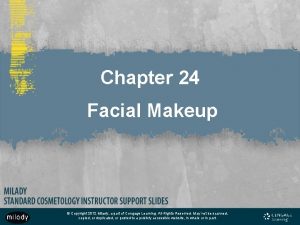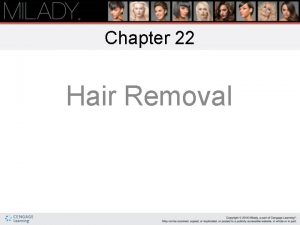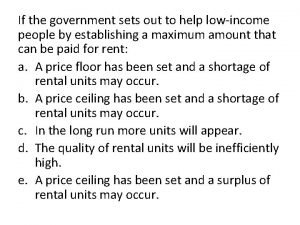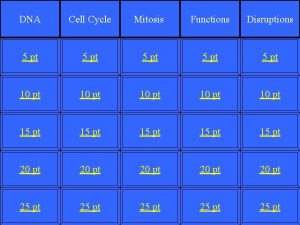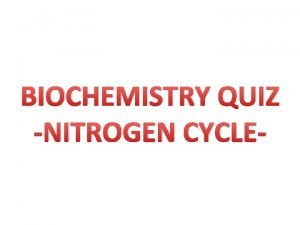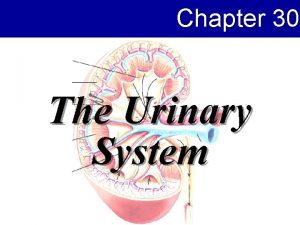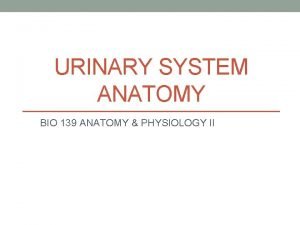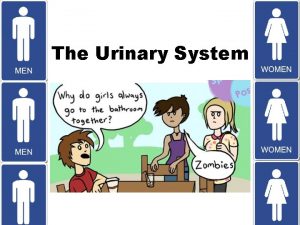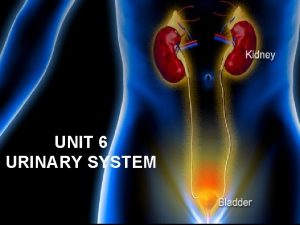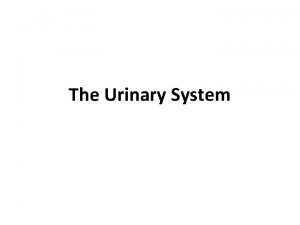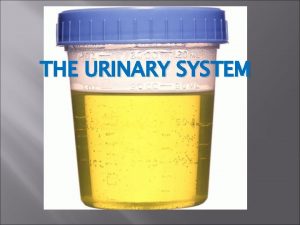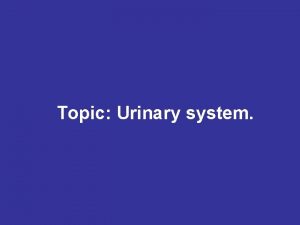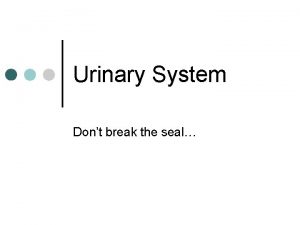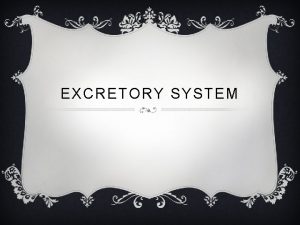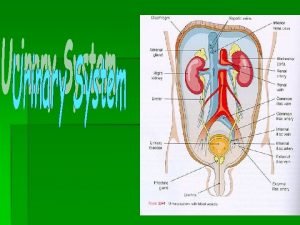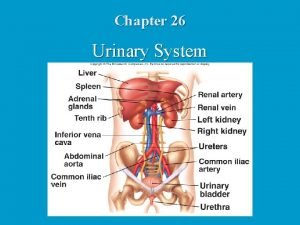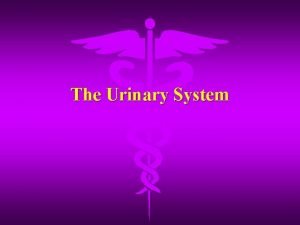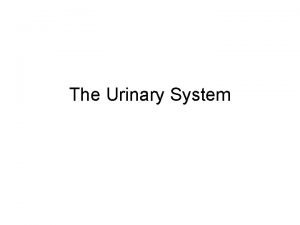Urinary system Functions of Urinary System Removes waste
















- Slides: 16

Urinary system

Functions of Urinary System • Removes waste • Maintains acid-base balance of body • Parts include: – – 2 KIDNEYS 2 URETERS BLADDER URETHRA

Kidneys • 2 bean shaped organs • Protected by ribs and fat • Each kidney is found in mass of fatty tissue (adipose capsule) • 2 main sections: – Cortex: outer layer, contains most of the neurons that aid in production of urine – Medulla: inner layer, contains most of tubes that carry urine from the nephrons through the kidneys

Nephrons • Microscopic filtering units • Over 1 million/kidney • Contains glomerulus – Cluster of capillaries that filter waste • Bowman’s capsule – Surround glomerulus picks up filtered materials and passes it to the convoluted tubule – Substances needed by the body are reabsorbed and returned to the capillaries • At the end, most of the water, sugar, vitamins and salts have been reabsorbed • Excess salts, water, wastes remain in the tubule and become urine • Urine enters collecting ducts (tubes) in the medulla • Collecting tubes empty into the renal pelvis (first section of the ureter)

Ureters • 2 muscular tubes 10 -12 inches long • One extends from the renal pelvis to the bladder • Peristalsis: a wavelike motion of the involuntary muscle that moves urine through the ureter from the kidney to the bladder

Bladder • Hollow muscular sac • Lining folds called rugae – disappears as muscles of bladder allow it to expand fill with urine • 3 layers of visceral muscle • Urge to void occurs when bladder contains 1 cup • Circular sphincter muscle – Control bladder opening – Can’t be controlled by infants • FUNCTIONS: – Receives urine from ureters – Stores urine until eliminated from body

Urethra • Tube carries urine from bladder to outside • External opening called meatus • Different in male/females – Females shorter – Opens in front of vagina or passes through the penis – Male: carries both urine from urinary system and semen from the reproductive system Urine • Liquid waste • 95% water • Excess useful products like sugar can be found, but usually indicates disease • 1 ½ - 2 quarts produced daily • 150 quarts filtered through kidneys

Key Terms • • Polyuria: excess urination Oliguria: below normal urination Anuria: absence of urination Hematuria: blood in urine Nocturia: urination at night Dysuria: painful urination Retention: inability to empty bladder Incontinence: involuntary urination

Diseases Symptoms: • Frequent urination • Inflammation of the bladder • More common in females due to shortness of urethra • Dysuria and burning • Bladder spasm • Hematuria • ? Fever ? Treatment: • Antibiotics and increased fluid intake

Glomerulonephritis • • Inflammation of the glomerulus Usually follows strep infection Can be acute or chronic Symptoms: hematuria, hypertension, edema, fatigue, congestive heart failure, renal failure, death • Treatment: treat symptoms – Low salt diet, high blood pressure medicine, dialysis, transplant

Pyelonephritis • Inflammation of kidney tissue and renal pelvis • Usually caused by pus forming bacteria • Symptoms: chills, fever, back pain, dysuria, hematuria and pyuria • Treatment: antibiotics, increased fluid intake

Renal Calculi • Kidney stone formed when salts in urine settle • Small stones can be eliminated in urine • Large stones may become lodged • Symptoms: sudden pain, hematuria and retention • Treatment: increase fluids, pain meds, strain urine w/ gauze, lithotripsy, possible surgery

Renal Failure • Kidneys stop functioning • Acute – Caused by injury, poisoning, dehydration – Prompt treatment leads to good prognosis • Chronic – Progressive loss of kidney function caused by glomerulonephritis, hypertension, toxins and endocrine disease. – Waste accumulates and affects body systems

Uremia • Toxic condition where urinary waste is in bloodstream • Caused from any condition that affects proper function of kidneys • Symptoms: n/v, ammonia breath, anuria, headache and confusion, coma/death • Treatment: restrictive diet, dialysis, transplant

Urethritis • Inflammation of the urethra • Caused by bacteria, viruses or chemicals • Symptoms: painful urination, redness, itching at meatus, ? discharge • Treatment: sitz baths or warm compresses, antibiotics, increased fluid intake

Identify parts of Urinary system • Use handout to label all parts of the urinary system • Use handout to trace flow of urine through the urinary system (name all parts as you go)
 Milady makeup chapter 20
Milady makeup chapter 20 Removes selected text and places it on the clipboard
Removes selected text and places it on the clipboard Chapter 22 milady exam questions
Chapter 22 milady exam questions Price ceilings will impose costs on society because they:
Price ceilings will impose costs on society because they: Mustard gas removes guanine from dna
Mustard gas removes guanine from dna Nitrification is indicated by the letter(s) _____.
Nitrification is indicated by the letter(s) _____. Spleen function
Spleen function Urinary system introduction
Urinary system introduction Figure 15-3 is a diagram of the nephron
Figure 15-3 is a diagram of the nephron Urethr/o medical terminology
Urethr/o medical terminology Interesting facts about urinary system
Interesting facts about urinary system Allantoic stalk fetal pig
Allantoic stalk fetal pig Chapter 30 the urinary system workbook answers
Chapter 30 the urinary system workbook answers Chapter 15 the urinary system figure 15-3
Chapter 15 the urinary system figure 15-3 Chapter 20 urinary/excretory system
Chapter 20 urinary/excretory system Urinary system model
Urinary system model Urinary system model
Urinary system model
